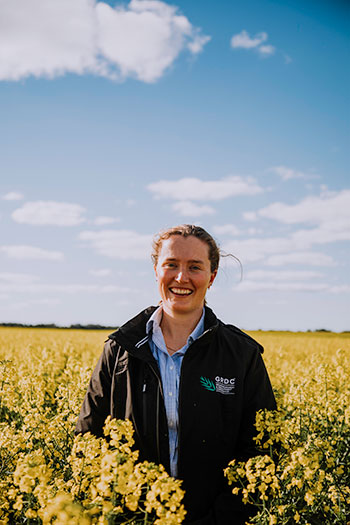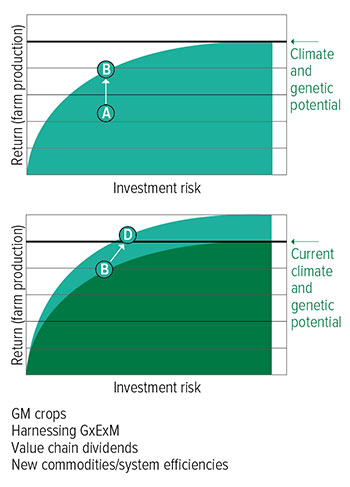GRDC’s applied research, development and extension general manager Peter Carberry is passionate about the National Grower Network (NGN). With his family running a cropping farm in north-western New South Wales, he understands well the challenges faced by grain growers and the need to access the latest information to manage emerging and immediate issues and to support on-farm innovation.
A new approach to the NGN started in July and is expected to take 12 months to fully transition across the regions.
Dr Carberry recently met Western Australian grain growers to explain the changes to the network and how GRDC will be better-placed to respond to local issues.
The NGN is GRDC’s front door for those who want to engage with us. This is a platform for all growers, advisers, farming groups and members of the broader grains industry to connect directly with our teams.
New approach aims to deliver more responsive RD&E
Evolving the way it approaches applied research, development and extension (RD&E) with the Australian grain growing community is set to be a major focus for GRDC over the next 12 months.
The establishment of the National Grower Network (NGN) – and how it will positively affect RD&E in areas such as yield gaps – was the key focus of a presentation delivered by GRDC applied RD&E general manager Peter Carberry at the Grower Group Alliance 2021 Grower Forum, held in Perth recently.
In 2020, GRDC announced the NGN would replace the Regional Cropping Solutions Network (RCSN) and Grower Solutions Group (GSG) model as a nationally consistent approach to identifying priority grains industry issues.
“The NGN will provide a crucial touch point with key growers, advisers and researchers,” Dr Carberry said at the grower forum. “It will identify opportunities and constraints in order to gather local experience and determine their relative importance to inform GRDC investments.
 GRDC grower relations manager Rachel Asquith during a grower event in August. Photo: GRDC
GRDC grower relations manager Rachel Asquith during a grower event in August. Photo: GRDC
“The network will form a two-way flow of information to ground-truth and research outcomes.”
In the past, the RCSN/GSG models have had a defined member base with reliance on structured member meetings and a geographic spread of grower representatives.
It was a single investment pathway with low agility that involved third-party facilitation and coordination, as well as GRDC regional panel involvement through advice on investment proposals.
The new NGN approach will see GRDC move to a more voluntary, inclusive and community-based approach.
“In essence, we’re taking the best of the old model and developing a more responsive, consistent and open forum to deliver locally validated RD&E,” Dr Carberry said.
“We have recognised the need to be even more responsive to local and seasonal issues and we also want to create a stronger and more direct connection with a broad base of growers, advisers and researchers to inform investment, which will help maximise farmgate profits.”
The new system will have a more extensive geographic reach with more direct local touch points and will utilise GRDC-branded forums and other mechanisms for identifying grower issues that are accessible to everyone.
The facilitation and coordination will be conducted by GRDC staff and there will be multiple investment pathways to expedite investment response.
Finally, the GRDC regional panels will be more involved in local issue prioritisations and response.
“Over the coming year, we will be moving our NGN towards a more community-based approach from the current membership model,” Dr Carberry said.
“We will also be increasing the number of GRDC Grower Forums by about 50 per cent, including the popular GRDC ‘Summer Sesh’ forums.
“To reduce duplication, we will also tap into other existing industry meetings to make the most of the time that growers already contribute to supporting RD&E.”
Key reasons
There were four key reasons that drove the decision to move to the NGN structure, with the need for a more timely response to local needs the most important.
The NGN will provide new investment pathways that consider impact, cost and risk, and there will be revised GRDC stages for approval and action.
Stronger and more direct GRDC connection was another of the key drivers for change, with the facilitation and coordination of the networks to be brought in-house, allowing for more contact with GRDC staff and the building of relationships to provide direct insights.
Dr Carberry said another part of the decision behind creating the NGN model was to allow for greater engagement with GRDC investments. “It will ensure broader reach to demonstrate impact, allow for feedback on opportunities and constraints and empower participatory research to facilitate adoption and measure impact,” he said.
“The last reason was driven by a desire to reduce duplication in ‘ideas capture’ by recognising other existing mechanisms and valuing growers’ time.”
 Figure 1: Efficiency frontier. Source: GRDC
Figure 1: Efficiency frontier. Source: GRDC
In future, GRDC forums will be four hours in length and feature researchers and speakers of local interest, as well as facilitated discussion and more engagements. The forums will stay within the port zones, but there will be five extra meetings per year and the issues raised will be prioritised on the day.
On the other hand, proxy meetings will allow GRDC to tap into existing opportunities – such as grower groups, research committees, agronomy groups or reseller groups – which will enable engagement that is bespoke to opportunity.
During his presentation, Dr Carberry made it clear that the NGN is largely about closing the yield gap and helping growers improve what they are already doing.
He said GRDC’s RD&E Plan 2018–23 identified the yield gap as the difference between what growers are producing now at a paddock level and what they should be producing when highly efficient in using current knowledge and technologies.
“With no further increase in cost, risk or investment, growers can increase their return by becoming better at what they are already doing – that’s where extension comes in and the application of development and extension efforts to help growers get from A to B and become more efficient,” he said.
“There is an ‘efficiency frontier’ of good practice, which reflects the different level of investment by growers – some may invest more or less depending on a range of circumstances including expected returns and risk level.
“We want all Australian grain growers to be somewhere on the curve moving them from A to B towards the efficiency frontier.”
GRDC’s approach to the NGN over the coming years is aimed squarely at addressing local issues and being agile with its extension activities. “To increase profitability, we need to increase new opportunities to push the efficiency frontier further upwards – and you can only do that through innovation driven by research, leading to new practices to deliver that productivity.
“GRDC is investing in a range of investments that are driving that change – not necessarily more or better but also different. Rather than just being more efficient, growers will need to look to practice/technical change to create new efficiency frontiers.”
In an ideal world, Australian grain growers can continue to increase their productivity and profitability by becoming more technically efficient using current farm practices and by adopting new practices through technical change.
The NGN structure will help GRDC to invest in both directions, recognising that every grower and every business is different.

























































